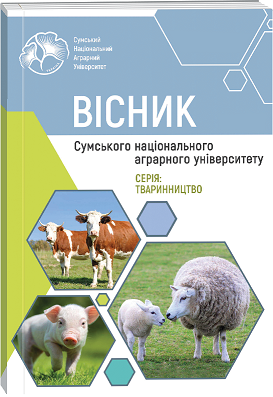PHYSIOLOGICAL FUNCTION OF ISOMALTOSE OLIGOMERIC AND ITS APPLICATION IN FEED INDUSTRY
Abstract
The present review article highlights the results of modern research on the development and use of phytogenic additives in the feeding of farm animals and poultry. Particular attention is paid to the analysis of the effectiveness of phytogenic additives as an alternative to antibiotics aimed at improving animal health, increasing their productivity and improving the quality of meat raw materials. The materials of the article serve as a basis for an analytical synthesis of modern approaches to solving the problem of reducing the use of antibiotics in livestock and poultry farming, which is important for ensuring food safety and preserving ecological balance. Today, isomaltose oligosaccharide is a promising green feed additive that can replace antibiotics due to its unique biological properties. As a feed additive, isomaltulose can promote the growth of bifidobacteria in the intestinal tract, inhibit the growth of Escherichia coli, which, according to our research, has a positive effect on improving the functioning of the intestine and improving its internal bacterial environment, while improving animal health. Isomaltose also helps to strengthen the immune system of animals by stimulating the growth of beneficial microflora in the intestines. It supports the health of the digestive system, reducing the risk of developing infectious diseases. In addition, this additive is environmentally friendly and does not cause antibiotic resistance, making it safe for both animals and consumers of their products. In addition, the use of isomaltose is aimed at reducing the use of chemicals in livestock farming, ensuring improved product quality and safety for the end consumer. The introduction of isomaltose into livestock production is an important step towards the sustainable development of the poultry industry. The use of isomaltose as a feed additive in poultry production meets modern environmental standards and helps to improve product quality without harming the environment. This article also focuses on the physiological function of isomaltulose, its unique properties and prospects for use in the feed industry. The article discusses its impact on metabolism, its ability to provide animals with energy for a long time, and its role in maintaining a healthy intestinal microflora. Special emphasis is placed on the possibility of using isomaltulose as an effective ingredient for the creation of high-quality and safe feed that meets modern standards in animal husbandry.
References
2. DING Bole, CAI Weirong, WEN Zhiying, YUE Danwei, ZHU Ying, LI Jingjing. (2020). Preparation and isolation of yam oligosaccharides and its proliferation effect on five probiotics strains [J]. Food and Fermentation Industries, 2020, 46(24): 74–79. https://doi.org/10.13995/j.cnki.11-1802/ts.024526
3. Tymczyszyn E.E., Santos M.I., Costa M.C., A. and Gómez-Zavaglia A. (2014). History, synthesis, properties, applications and regulatory issues of prebiotic oligos Illanes accharides. Publisher: Research Signpost, T.C. 37/661 (2), Fort P.O., Trivandrum-695 023 Kerala, India (pp. 127–154)
4. Fawen Dai, Shiwei Zhao, Xia Huang, Hang Yu. (2024). Effects of dietary fat sources on growth performance, lipid metabolism and intestinal health of weaned piglets. Journal of Applied Animal Research. 52(1) 2024, VOL. 52, Nо. 1, 2384417. DOI: 10.1080/09712119.2024.2384417
5. Gormley, A., Jang, K. B., Garavito-Duarte, Y., Deng, Z., & Kim, S. W. (2024). Impacts of Maternal Nutrition on Sow Performance and Potential Positive Effects on Piglet Performance. Animals, 14(13), 1858. https://doi.org/10.3390/ani14131858
6. H. REHMAN, W. VAHJEN, A. KOHL-PARISINI, A. IJAZ and J. ZENTEK. (2009). Influence of fermentable carbohydrates on the intestinal bacteria and enteropathogens in broilers. Worlds Poultry Science Journal.2009, 65(1):75–89. DOI: 10.1017/S0043933909000063
7. Hayakawa T, Masuda T, Kurosawa D, Tsukahara T. (2016). Dietary administration of probiotics to sows and/or their neonates improves the reproductive performance, incidence of post-weaning diarrhea and histopathological parameters in the intestine of weaned piglets. Anim Sci J. 2016 Dec; 87(12):1501–1510. doi: 10.1111/asj.12565. Epub 2016 Mar 28. PMID: 27018090.
8. Innamma N, Ngamwongsatit N, Kaeoket K. (2023). The effects of using multi-species probiotics in late-pregnant and lactating sows on milk quality and quantity, fecal microflora, and performance of their offspring. Vet World. 2023 Oct; 16(10):2055–2062. doi: 10.14202/vetworld.2023.2055-2062. Epub 2023 Oct 7. PMID: 38023266; PMCID: PMC10668563.
9. Ma, Y., Sun, Z., Zeng, Y., Hu, P., Sun, W., Liu, Y., Hu, H., Rao, Z., & Tang, Z. (2021). Isolation, Identification and Function of Pichia anomala AR and Its Effects on the Growth and Health of Weaned Pigs. Animals, 11(4), 1179. https://doi.org/10.3390/ani11041179
10. Mazur-Kuśnirek M, Lipiński K, Jørgensen JN, Hansen LHB, Antoszkiewicz Z, Zabielski R, Konieczka P. (2023). The Effect of a Bacillus-Based Probiotic on Sow and Piglet Performance in Two Production Cycles. Animals (Basel). 2023 Oct 10;13(20):3163. doi: 10.3390/ani13203163. PMID: 37893887; PMCID: PMC10603631.
11. Mizubuchi H, Yajima T, Aoi N, Tomita T, Yoshikai Y. (2005). Isomalto-oligosaccharides polarize Th1-like responses in intestinal and systemic immunity in mice. J Nutr. 2005 Dec; 135(12):2857–61. doi: 10.1093/jn/135.12.2857. PMID: 16317132.
12. Sandeep Kumar, Trisha Tissopi, Sarma Mutturi (2023).The successful synthesis of industrial isomaltooligosaccharides lies in the use of transglycosylating α-glucosidases: A review, Carbohydrate Polymer Technologies and Applications, Volume 5, 100325. https://doi.org/10.1016/j.carpta.2023.100325.
13. Tathiana Souza Martins Meyer, Ângelo Samir Melim Miguel, Daniel Ernesto Rodríguez Fernández and Gisela Maria Dellamora Ortiz (2015). Biotechnological Production of Oligosaccharides – Applications in the Food Industry. Food Production and Industry (pp. 25–78). http://dx.doi.org/10.5772/60934
14. Teruo Nakakuki (2002). Present Status and Future Prospects of Functional Oligosaccharide Development in Japan. Journal of Applied Glycoscience 74(7):1245–1251. DOI: 10.1351/pac200274071245
15. Thitaram SN, Chung CH, Day DF, Hinton A Jr, Bailey JS, Siragusa GR. (2005). Isomaltooligosaccharide increases cecal Bifidobacterium population in young broiler chickens. Poult Sci. 2005 Jul; 84(7):998–1003. doi: 10.1093/ps/84.7.998. PMID: 16050115.
16. Wang XX, Song PX, Wu H, Xue JX, Zhong X, Zhang LY. (2016). Effects of Graded Levels of Isomaltooligosaccharides on the Performance, Immune Function and Intestinal Status of Weaned Pigs. Asian-Australas J Anim Sci. 2016 Feb; 29(2):250–6. doi: 10.5713/ajas.15.0194. PMID: 26732450; PMCID: PMC4698705.
17. X. Wang, Y. Z. Farnell, E. D. Peebles, A. S. Kiess, K. G. S. Wamsley, and W. Zhai (2016). Effects of prebiotics, probiotics, and their combination on growth performance, small intestine morphology, and resident Lactobacillus of male broilers. Poultry Science 95(6). DOI: 10.3382/ps/pew030
18. XIAO J, MA Sorgog, ZHANG Yuan-yuan. (2022). Research Progress on the Roles of Functional Oligosaccharides and Sugar Alcohols in Promoting Intestinal Absorption of Minerals in Rats[J]. Animal Husbandry and Feed Science, 2022, 43(3): 59–63. https://journal30.magtechjournal.com/xmysl/EN/Y2022/V43/I3/59
19. Xu, T., Sun, R., Zhang, Y., Zhang, C., Wang, Y., Wang, Z. A., & Du, Y. (2022). Recent Research and Application Prospect of Functional Oligosaccharides on Intestinal Disease Treatment. Molecules, 27(21), 7622. https://doi.org/10.3390/molecules27217622
20. Ya-Jun Li, Guang-Yong Zhao, Wen Du, Tie-Jun Zhang (2009). Effect of dietary isomaltooligosaccharides on nutrient digestibility and concentration of glucose, insulin, cholesterol and triglycerides in serum of growing pigs[J].Animal Feed Science and Technology, Volume 151, Issues 3–4, 26 May 2009, Pages 312–315. https://doi.org/10.1016/j.anifeedsci. 2009.01.012
21. Zhang WF, Li DF, Lu WQ, Yi GF. (2003). Effects of isomalto-oligosaccharides on broiler performance and intestinal microflora. Poultry Science Volume 82, Issue 4, 1 April 2003, Pages 657–663. https://doi.org/10.1093/ps/82.4.657

 ISSN
ISSN  ISSN
ISSN 



